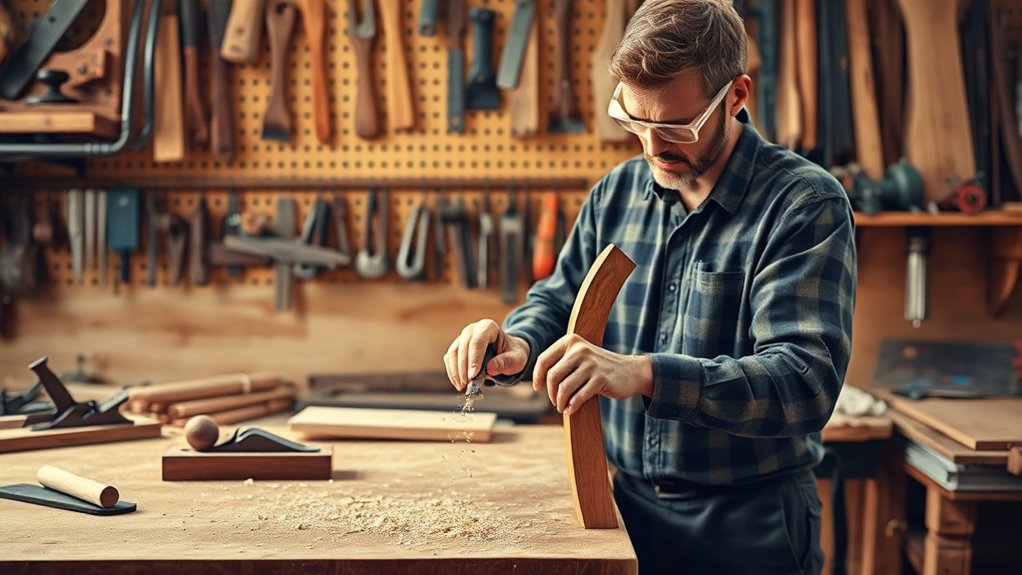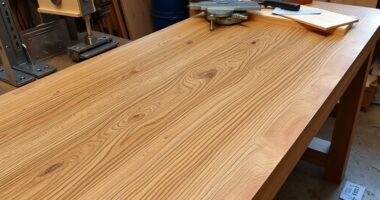Many woodworking myths can lead you astray, like believing all wood behaves the same or that expensive tools guarantee perfect results. In reality, choosing the right wood, understanding proper techniques, and managing wood movement are key. You don’t need costly equipment or fancy skills to start; simple tools and patience often suffice. Keep exploring, and you’ll discover how debunking these myths can boost your confidence and improve your projects.
Key Takeaways
- Not all woods are suitable for every project; choosing the right species prevents warping and failure.
- High-quality tools are essential; cheap tools can hinder progress and compromise safety.
- Traditional methods with simple tools can produce professional results without expensive equipment.
- Wood movement is manageable with proper joinery and species selection, ensuring project durability.
- Precise measurements and patience are crucial; approximate cuts lead to misalignment and wasted effort.

Many people believe woodworking is straightforward or that certain rules must always be followed, but these ideas are myths that can hinder your progress. The truth is, woodworking is a nuanced craft that requires understanding, flexibility, and practice.
For example, many assume all wood is the same, but this couldn’t be further from the truth. Different species have unique properties that impact how you work with them and how they perform over time. Hardwoods and softwoods aren’t just different in hardness—they have different cellular structures, moisture contents, and movement behaviors. If you pick the wrong type of wood for a project, it can lead to warping, cracking, or failure down the line. Recognizing these differences helps you select materials suited for your specific needs, ensuring your project lasts.
Another common myth is that woodworking is cheap to start. While you can find some inexpensive tools and materials, quality tools and proper workspace come with a cost. Many beginners underestimate the investment needed to produce durable, professional-looking pieces. Mass-produced furniture often costs less than the raw materials for a DIY project, but the value of handcrafting lies in the quality and longevity of your work.
Skilled woodworkers often turn their craft into a business, which can help offset the initial costs. This means that, rather than saving money, you’re investing in a skill that can pay dividends over time.
Some believe you need expensive or specialized tools to get started, but that’s not true. Basic woodworking can be done with affordable, everyday tools. Precision and technique matter far more than having the highest-end equipment. Many traditional joinery methods rely on simple hand tools that are inexpensive and effective.
Poorly matched or low-quality tools can cause frustration and subpar results, so it’s better to learn proper technique with simple tools before investing in more complex gear. As your skills grow, so can your tool collection, but it’s not a requirement from the outset.
A persistent myth is that wood movement will ruin your project. Wood does naturally expand and contract with moisture changes, but this is manageable. With proper joinery, allowances, and understanding of the species you’re working with, you can design projects that accommodate these movements without failure. Understanding wood behavior is essential for creating durable pieces. Additionally, studying wood properties can help you predict how different woods will respond in various environments, further reducing the risk of issues. Recognizing that some woods are more stable than others can influence your design choices and improve project longevity.
Not all woods behave the same way; some are more stable than others, and the orientation of the cut influences movement. When you understand these behaviors, you’ll be able to build durable, stable pieces without fear of warping or cracking.
Many believe there’s only one “right” way to woodwork, but that’s untrue. There are numerous valid methods—hand-cut joinery, pocket screws, CNC machining—each with its strengths and applications. Safety and structural integrity are the priority, not strict adherence to one technique.
Different styles and cultures have developed their own approaches, and experimenting with these broadens your skills. Being open to multiple techniques encourages growth and innovation, rather than limiting you to rigid rules.
Lastly, some think measurements can be approximate. Precision is critical in woodworking; “close enough” often results in misaligned parts and wasted effort. Double-checking measurements and taking your time ensures accuracy and a quality finish.
Imprecise cuts lead to frustration and compromise craftsmanship. Patience, attention to detail, and careful measurement are essential for successful projects. Embracing these truths helps you avoid common pitfalls and develop your skills effectively. Proper measurement techniques are fundamental to delivering high-quality results.
Conclusion
Now that you’ve busted these woodworking myths, you can approach projects with confidence, knowing the truth behind common misconceptions. Don’t let old tales from your grandpappy’s workshop hold you back—modern tools and techniques are here to help you craft like a pro. Remember, even in a world where steam engines rule the streets, skills and knowledge still reign supreme. Keep learning, experimenting, and creating—your masterpiece awaits, just like a true artisan of old.









